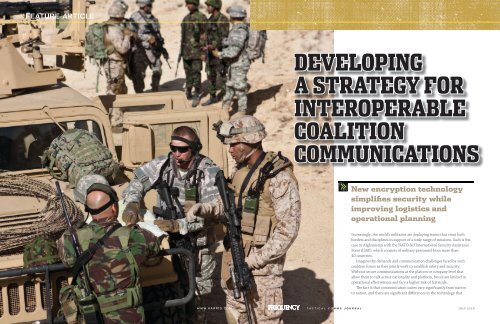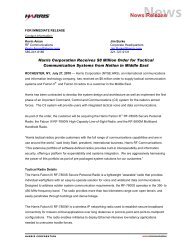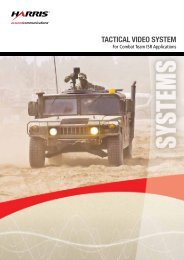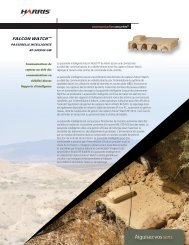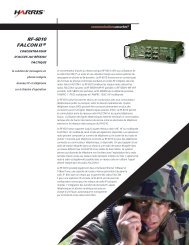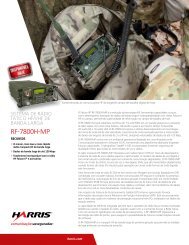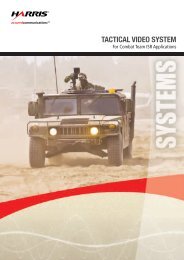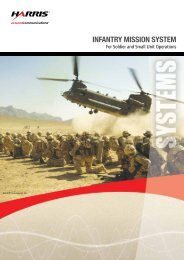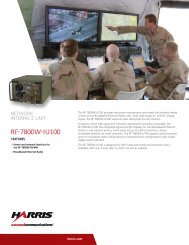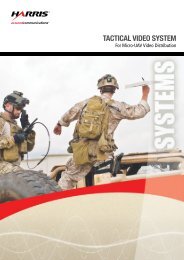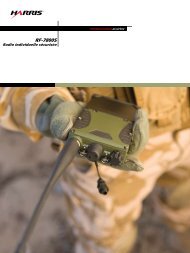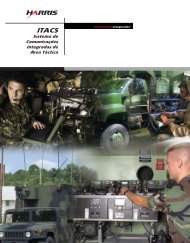Developing a Strategy for interoperable Coalition CommuniCationS
Developing a Strategy for interoperable Coalition CommuniCationS
Developing a Strategy for interoperable Coalition CommuniCationS
You also want an ePaper? Increase the reach of your titles
YUMPU automatically turns print PDFs into web optimized ePapers that Google loves.
feature article<br />
<strong>Developing</strong><br />
a <strong>Strategy</strong> <strong>for</strong><br />
Interoperable<br />
<strong>Coalition</strong><br />
Communications<br />
»<br />
New encryption technology<br />
simplifies security while<br />
improving logistics and<br />
operational planning<br />
Increasingly, the world’s militaries are deploying teams that cross both<br />
borders and disciplines in support of a wide range of missions. Such is the<br />
case in Afghanistan with the NATO-led International Security Assistance<br />
Force (ISAF), which consists of military personnel from more than<br />
40 countries.<br />
Imagine the demands and communication challenges faced by such<br />
coalition <strong>for</strong>ces as they jointly work to establish safety and security.<br />
Without secure communications at the platoon or company level that<br />
allow them to talk across nationality and plat<strong>for</strong>m, <strong>for</strong>ces are limited in<br />
operational effectiveness and face a higher risk of fratricide.<br />
The fact is that communication suites vary significantly from nation<br />
to nation, and there are significant differences in the technology that<br />
10 j u l y 2 0 1 0 w w w . h a r r i s . c o m<br />
T A C T I C A L C O M M S J O U R N A L j u l y 2 0 1 0
each nation employs—thereby<br />
leading NATO to demonstrate the<br />
need <strong>for</strong> standardization in areas such<br />
as wave<strong>for</strong>ms.<br />
The availability of universal<br />
cryptographic equipment is the biggest<br />
technical obstacle. While it is common<br />
to find NATO-approved Type-1<br />
equipment on the battlefield, there<br />
is a need <strong>for</strong> a new class of scalable,<br />
coalition-releasable, cryptographic<br />
equipment. The goal: To make it easier<br />
<strong>for</strong> U.S., NATO, and coalition partners<br />
to communicate on the battlefield.<br />
Enter Suite B<br />
A new set of commercial<br />
cryptographic algorithms known as<br />
Suite B offers military communicators<br />
a simpler, more effective yet still secure<br />
path to interoperability across a broad<br />
range of operating environments,<br />
including classified High-Grade/Top<br />
Secret or <strong>Coalition</strong>/Sensitive But<br />
Unclassified (SBU) applications. Suite B<br />
covers specifications and functions such<br />
as encryption, digital signature, key<br />
exchange, and hashing.<br />
Collaborating with the National<br />
Security Agency, Harris Corporation<br />
has produced the first radio with<br />
Suite B algorithms—the Falcon III®<br />
RF-310M-HH Suite B Compatible<br />
Multiband Handheld Radio. The<br />
RF-310M utilizes this new encryption<br />
technology to make it easier <strong>for</strong> U.S.<br />
<strong>for</strong>ces and coalition partners to<br />
communicate on the battlefield,<br />
resulting in improved coordination,<br />
easier mission planning, and reduced<br />
instances of friendly fire.<br />
The RF-310M is a multiband,<br />
multi-mission, software-defined Suite B<br />
radio certified by the NSA to transmit<br />
voice and data up to the U.S. SECRET<br />
level. It delivers the advantages of<br />
encrypted wave<strong>for</strong>m interoperability<br />
without the handling rules and<br />
regulations governing controlled<br />
cryptographic items (CCI). (A CCI radio<br />
or device may be unclassified but is<br />
subject to special accounting controls<br />
and markings. For example, active duty<br />
observers must accompany any CCI<br />
device into coalition operations; the<br />
RF-310M, as a non-CCI item, would<br />
not face the same requirement.)<br />
Mission interoperability<br />
Depending on the mission profile,<br />
warfighters may require NATO Secret,<br />
NATO Restricted, and/or Mission<br />
Secret data. As a non-CCI Suite B<br />
communication device, the Harris<br />
RF-310M-HH can provide secure<br />
interoperability using a common<br />
key management system. <strong>Coalition</strong><br />
interoperability occurs through the use<br />
of this common key material, as well as<br />
a standard VHF/UHF Line-of-Sight<br />
wave<strong>for</strong>m using the Suite B Advanced<br />
Encryption Standards (AES) algorithm.<br />
The end result: the RF-310M may be<br />
easily exported to NATO nations <strong>for</strong><br />
their own sovereign use with national<br />
key management systems, but can easily<br />
be updated to support coalition operations.<br />
“The RF-310M-HH meets the<br />
varying communication needs of the<br />
U.S. government, NATO, and coalition<br />
<strong>for</strong>ces and provides an easy, costeffective<br />
way to trans<strong>for</strong>m the ad hoc<br />
nature of communications among<br />
coalition partners in conflicts such<br />
as in the war in Afghanistan,” said<br />
Todd Moore, director, secure products<br />
<strong>for</strong> Harris RF Communications. “Suite B<br />
technology is poised to help nations<br />
around the world cross communication<br />
borders and securely interoperate<br />
through the coalition.”<br />
Cryptographic functions<br />
Because Suite B is based on<br />
commercially available technology, the<br />
dependency on <strong>for</strong>eign governments <strong>for</strong><br />
the evaluation, monitoring, control, and<br />
release of communications equipment<br />
is diminished. Programmable<br />
communication products such as radios<br />
and inline network encryptors (INE)<br />
may also be endorsed <strong>for</strong> multinational<br />
or coalition operational use by providing<br />
verification evidence on these standards<br />
through the NSA or other commercial<br />
certification processes.<br />
Another important aspect <strong>for</strong> any<br />
<strong>interoperable</strong> coalition is the definition<br />
of a common key that can be used by<br />
all parties. The Suite B public key<br />
management approach builds on existing<br />
standards—including certificate<br />
management and key registration—<br />
that are also currently used by several<br />
commercial organizations such as banks.<br />
This approach increases the number of<br />
available organizations, including Harris,<br />
that can produce trusted key sources.<br />
Remote command and control and<br />
over-the-network key de-registration are<br />
essential elements of Suite B. Both enable<br />
a coalition tactical communications network to be <strong>for</strong>med quickly<br />
and exchange the appropriate key material. The latter mechanism,<br />
in particular, allows a unit to be removed from a coalition<br />
network seamlessly without impacting day-to-day operations.<br />
High-grade interoperability standards<br />
The NSA has defined three high-grade scalable interoperability<br />
standards to date: High Assurance Internet Protocol Encryptor<br />
(HAIPE); Link Encryption Family (LEF); and Secure<br />
Communications Interoperability Protocol (SCIP).<br />
The interoperability goal set <strong>for</strong>th by the NSA is to produce<br />
worldwide products—like the Harris RF-310M-HH radio—that<br />
could support these standards in these specific implementations.<br />
The latest revisions of each contain a Suite B-only version, which<br />
can be used in coalition interoperability applications with the<br />
appropriate implementation, review, and approval. While the<br />
three interoperability standards define the interoperability<br />
protocol, Suite B technology provides greater access to coalition<br />
<strong>for</strong>ces to actually achieve it.<br />
Sample operational scenarios<br />
Multinational (NATO and non-NATO) <strong>for</strong>ces operating in<br />
NATO mission areas that require <strong>interoperable</strong> secure tactical<br />
communications can benefit from a Suite B solution. For example,<br />
infantry platoons/sections from different nations operating<br />
together in search operations in Afghan villages need secure<br />
communications at the platoon/company level or they are limited<br />
in effectiveness. Similarly, Forward Area Controllers (FACs)<br />
requesting support from NATO/U.S. aircraft currently require<br />
use of CCI Type 1 radios.<br />
The current NATO security requirements are difficult to apply<br />
to “coalition of the day” operations because of the different levels<br />
involved. A non-CCI Suite B communication device would provide<br />
secure interoperability using a common key management system.<br />
Because the RF-310M is software defined, its programmability<br />
would allow <strong>for</strong> implementing advanced features such as<br />
detection of malicious software.<br />
These product solutions can easily provide secure communications<br />
solutions <strong>for</strong> the U.S. military and find application in a broad set<br />
of solutions providing interoperability to municipal homeland<br />
security, border patrols, and other first responders.<br />
Ultimately, the delivery of a single communication device that<br />
serves multiple mission purposes reduces the logistical burden and<br />
cost of maintaining multiple pieces of communication equipment<br />
and facilitates ease-of-use and coalition interoperability—all<br />
while providing an effective secure communications environment<br />
<strong>for</strong> a global partnership. •<br />
Harris Produces<br />
First NSA-Certified<br />
Suite B Radio<br />
Military <strong>for</strong>ces engaged in coalition warfighting can now<br />
deploy new Suite B encryption technology to the battlefield<br />
with a new radio from Harris Corporation.<br />
The Harris Falcon III® RF-310M-HH, introduced in the<br />
summer of 2009, is the first Type-1 Suite B compatible<br />
radio to be certified by the National Security Agency.<br />
The RF-310M-HH is secured with Suite B compatible<br />
cryptography and key management techniques,<br />
incorporating Harris Sierra IIB programmable encryption.<br />
The Advanced Encryption Standard (AES) and keying<br />
standards are used to handle voice and data traffic at the<br />
U.S. Secret level and below. Suite B cryptography provides<br />
a common set of cryptographic algorithms to meet the<br />
varying communications needs of U.S. government, NATO,<br />
and coalition <strong>for</strong>ces through locally generated, independent<br />
sovereign key management. The radio features the same<br />
JTRS Software Communications Architecture (SCA)<br />
operating environment as the JTRS-Approved Falcon III<br />
AN/PRC-152 handheld radio.<br />
In addition to military use, the RF-310M is also ideal <strong>for</strong><br />
homeland security operations. The radio supports secure<br />
communications that bridge the gap between U.S DoD<br />
agencies, emergency first responders, and state and local<br />
agency personnel.<br />
Covering the 30 to 512 MHz frequency range, the<br />
RF-310M-HH provides selectable RF output up to 5 watts.<br />
Current wave<strong>for</strong>m support includes VHF/UHF AM and FM<br />
and APCO P25, with future upgrades to<br />
include SCIP (AES) NATO STANAG and the<br />
Quicklook VHF/UHF ECCM wave<strong>for</strong>m.<br />
Key Features of the 310M-HH<br />
• Non-CCI device<br />
• SCA v2.2 compliant<br />
• Sierra IIB programmable crypto<br />
• Built-in speaker/mic<br />
• Full numeric keypad<br />
• NVG compatible display<br />
• Embedded GPS (optional)<br />
• MELP<br />
• Wireless cloning<br />
• Long-life internal Hold-up Battery<br />
(HUB)<br />
• Supports multiple mission plans<br />
j u l y 2 0 1 0 w w w . h a r r i s . c o m T A C T I C A L C O M M S J O U R N A L<br />
j u l y 2 0 1 0


